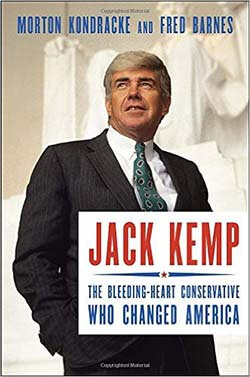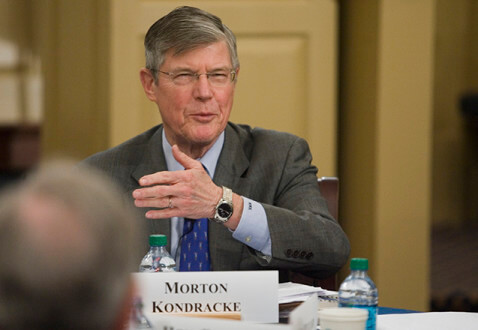Ricochet is the best place on the internet to discuss the issues of the day, either through commenting on posts or writing your own for our active and dynamic community in a fully moderated environment. In addition, the Ricochet Audio Network offers over 50 original podcasts with new episodes released every day.
 Morton Kondracke Replies to the New York Times
Morton Kondracke Replies to the New York Times
 Mort Kondracke and Fred Barnes have just published a marvelous book, Jack Kemp, the Bleeding Heart Conservative Who Changed America. Reviewing the book today, the New York Times slams it. Not only did the Kemp-Roth tax cut legislation of 1981 fail to do any good, Tim Noah, the reviewer, insists, but the legislation — the centerpiece, you will recall, of Reagan’s first-term economic reforms — proved “a disaster.”
Mort Kondracke and Fred Barnes have just published a marvelous book, Jack Kemp, the Bleeding Heart Conservative Who Changed America. Reviewing the book today, the New York Times slams it. Not only did the Kemp-Roth tax cut legislation of 1981 fail to do any good, Tim Noah, the reviewer, insists, but the legislation — the centerpiece, you will recall, of Reagan’s first-term economic reforms — proved “a disaster.”
Although the most genial of men, Mort Kondracke is fighting back. Below, a reply that he sent to a couple of dozen of his friends, asking us to publish it wherever we could. Honored to have been on that list, I hereby comply, and–as you are about to see, Mort’s takedown of Noah’s slovenly work is a thing of beauty — I do so with relish.
By Morton M. Kondracke
I feared that The New York Times would assign a Reagan-hater to review Jack Kemp: The Bleeding Heart Conservative Who Changed America. Mercifully, it didn’t pick Paul Krugman, who would have been savage. Instead, it chose Tim Noah, now of Politico, whose review is polite, just misguided.
First thing, he labels both me and co-author Fred Barnes “right of center,” which Fred definitely is, but I’m not. “Mushy moderate” is Fred’s characterization of me. Moderate Independent is what I call myself. He gets it wrong that Kemp passed his tax bill in 1978; it didn’t happen til 1981. He has Kemp serving as HHS Secretary under Bush 1; it was HUD. And he dismisses Kemp, whose life and political career were devoted to ideas, optimism, growth, civil rights and fighting poverty, as proof that “nice guys finish last.” That’s to throw cold water on the idea that Kemp could be (as we hope) a model for ever-warring contemporary politicians.
But the big policy beef I have with the review is the assertion that Kemp’s signal achievement—the across-the-board supply-side tax cut proposal (“Kemp-Roth”) that became the basis of Reaganomics– “was a disaster.”
According to Noah, “it inaugurated two decades of sky-high budget deficits, accelerated a nascent growth trend in income inequality and did (depending on who you ask) little or nothing to ease the brutal 16-month recession that began around the same time the bill was passed.”
 Noah systematically ignores the great economic turn-around in that Reagan achieved in the 1980s, using Kemp-Roth and then the 1986 tax reform partially developed by Kemp. He barely refers to the pre-Reagan 1970s — the era of “stagflation,” the “misery index” (unemployment up to 9 percent and inflation, 13.5 percent) and growth rates averaging 1.6 percent per year (vs. the post-war norm of 3.6 percent.)
Noah systematically ignores the great economic turn-around in that Reagan achieved in the 1980s, using Kemp-Roth and then the 1986 tax reform partially developed by Kemp. He barely refers to the pre-Reagan 1970s — the era of “stagflation,” the “misery index” (unemployment up to 9 percent and inflation, 13.5 percent) and growth rates averaging 1.6 percent per year (vs. the post-war norm of 3.6 percent.)
Noah is right that the 1981-83 recession was brutal. It was caused by Federal Reserve Chairman Paul Volcker’s successful efforts to crush inflation by raising interest rates above 20 percent. Reagan’s 1981 tax cuts, lowering the top rate from 70 percent to 50 and the middle-income rate from 37 percent to 23, did not take full effect until the end of the recession.
Afterwards, there was a boom, not a disaster. The economy grew 7.8 percent in 1983, 5.6 percent in 1984, 4.3 percent in 1985 and averaged 4.5 percent for the rest of Reagan’s presidency and 3.7 percent through 2000. (See for yourself here.) The misery index dropped from a high of 23 in 1980 to 7.7 in 1986 and 9.7 in 1989. (Again, see for yourself.)
Sixteen million jobs were created during the Reagan years, a record exceeded only by Bill Clinton’s 22.9 million. (Clinton raised the top income tax rate from 36 percent to 39.6 percent in 1993, but reduced the capital gains tax rate from 28 percent to 20 percent, a distinctly supply side action.) In terms of percentage gains in job numbers, Clinton scored 20.8 percent, Reagan 17.7. Barack Obama, as of the end of 2014, had produced only a 4.3 percent increase. But George W. Bush trails all recent presidents with just a one percent increase, raising legitimate questions about the Republican party’s belief that tax cuts are the solution to every problem. Tax reform, lowering rates and eliminating loopholes, is a good idea, though.
Back to Reagan: in 1979, only 13 percent of American adults were satisfied with the way things were going in the country, according to the Gallup poll. [“Satisfaction on Rise in U.S., Gallup Poll Finds” by Michael R. Kagay, New York Times, 25 Dec 1988, p. 18.] That number reached its highest-ever point, 66 percent, in March 1986 and was at 59 percent when Reagan left office.
Noah is correct to say that deficits expanded under Reagan, increasing the gross federal debt from $909 billion in 1980 to $2.9 trillion in 1989, or from 33.4 percent of GDP to 53.1 percent. But falling revenues do not account for the increase, averaging 18.2 percent a year, about the historic average (in spite of the tax rate cuts.) Spending increased dramatically, from 20 percent of GDP during the 1970s to 22.2 percent under Reagan. By comparison, the gross debt increased under Bush 43 from $5.6 trillion (57.3 percent of GDP) to $11.8 trillion (84.2 percent) and has gone from there to $19.3 trillion so far under Obama (to 102.7 percent of GDP). (The figures are all right here.)
Reagan’s increased outlays were mainly for defense — part of the “peace through strength” strategy that eventually toppled the Soviet Union — and for interest on the national debt, which had to be repayed in non-inflated dollars.
As to income inequality, everyone should read Washington Post fact-checker Glenn Kessler’s debunking article, “Elizabeth Warren’s claim that the bottom 90 percent got ‘zero percent’ of wage growth after Reagan.” (October 23). As Kessler wrote: “Families in the top 1 percent saw their after-tax income triple from 1970 to 2011, but other groups saw a sizable improvement in household incomes” when taxes and income transfers like the Earned Income Tax Credit are counted. The Congressional Budget Office calculated that Americans in the bottom fifth of incomes gained 50 percent and those in the middle fifth, 36 percent.
 Reagan (and Kemp) actually increased the progressivity of the US tax structure. In 1980, the top marginal income tax rate (paid by those making over $215,000 ) was 70 percent. And those people paid 19 percent of all income taxes. People in the middle bracket (making $30,000 a year) paid at a rate of 37 percent (the Clinton and Obama top rate). After Reagan (with help from Kemp) had passed the 1981 and 1986 tax cuts, those at the top were paying at a rate of 28 percent , but paying 55 percent of income taxes. Those below $30,000 paid a tax of 15 percent, but the personal exemption was raised to $2,000 and the standard deduction to $5,000, reducing their tax burden. The bottom 50 percent of taxpayers paid just 5.8 percent of all income taxes. (Yet again, take a look.)
Reagan (and Kemp) actually increased the progressivity of the US tax structure. In 1980, the top marginal income tax rate (paid by those making over $215,000 ) was 70 percent. And those people paid 19 percent of all income taxes. People in the middle bracket (making $30,000 a year) paid at a rate of 37 percent (the Clinton and Obama top rate). After Reagan (with help from Kemp) had passed the 1981 and 1986 tax cuts, those at the top were paying at a rate of 28 percent , but paying 55 percent of income taxes. Those below $30,000 paid a tax of 15 percent, but the personal exemption was raised to $2,000 and the standard deduction to $5,000, reducing their tax burden. The bottom 50 percent of taxpayers paid just 5.8 percent of all income taxes. (Yet again, take a look.)
Finally, Noah ignores the fact (see page 45 of our book) that Kemp modeled Kemp-Roth on proposals made by John F. Kennedy in 1962 and enacted after his death, dropping the top income tax rate from 90 percent to 70 percent. Kemp loved to quote Kennedy’s speech to the Economic Club of New York: “It is a paradoxical truth that tax rates are too high and tax revenues are too low. And the soundest way to raise revenues in the long run is to cut taxes now.” Kennedy’s proposals were hailed by Democrats at the time and opposed by Republicans as budget-busting. Most Democrats and practically every liberal (including Tim Noah) have forgotten that history.
The bottom line for me is that Kemp-Roth and Reaganomics worked — economically, politically, and geopolitically. We’re in trouble again as we were in the 1970s. Incomes are flat. Growth is glacial. Voters are furious. Washington is paralyzed. What we need is ideas, not insults and more division. That — plus the fact that Kemp deserved a biography—is why we wrote the book.
Published in Literature



Well said. This tackles one of the bulwarks of modern progressive revisionism.
But how are they doing without anyone else’s money? What about those of us who get no transfers and can’t afford shelters? Isn’t focusing on “the wealthy” and “the poor” to the exclusion of the vast majority of Americans the problem with both parties?
Thank you for publishing this response to the review of the book in the NYT. Jack Kemp was an important political figure and an equally important public figure, beyond the political sphere, and this book is a good evaluation of his career and contributions. So the response needs to be widely read.
There is one issue to bring up with Mr Kondrake: “the gross debt increased under Bush 43 from $5.6 trillion (57.3 percent of GDP) to $11.8 trillion (84.2 percent)”. This is not correct. It includes the deficit for Fiscal Year 2009, a significant part of which was due to the stimulus and to the fact that the appropriations for that year were not passed by Congress until after Obama was President.
As if we needed another reason to know that the NYT has lost all credibility as anything more than a partisan rag.
Reagan’s fiscal policies may not have been perfect but there were hardly any alternatives. It may seem quaint today to use fiscally-induced deflationary pressure to break a wage-price spiral, but that’s only because we haven’t had a wage-price spiral since.
Reagan’s policies were the best available during a very turbulent time, and they certainly worked. The tax cuts, in particular, had a pretty big supply-side effect that lasted a long time.
The same data that says the poor and the rich are better off also says the same thing about the middle three quintiles.
We’re all living longer in bigger houses with bigger beds, more conveniences, from air conditioning to TVs to computers to Ricochet to dishwashers. We all have more education, less crime, and better lives in just about every material respect.
It is a natural part of the human condition to believe that things are getting worse, but those that preach this false message and, worse, combine it with class warfare, are not your friends.
It is true that governments focus particularly on the top and bottom quintiles, because the government’s work is so heavily focused on helping people in need and helping the victims of people in need, and on policies that have most of their impact through the wealthy.
There are successes that have particularly helped the middle set, though; gun rights, freedom from unions, free trade, tax reductions (the middle quintiles may have benefited most there),and home schooling stand out.
Democrats are never going to let Reaganomics be seen as we saw it then and as I see it today as a huge success.
For some reason… probably their contention that capitalism in general is just evil… they will not acknowledge that supply side did what it promised.
I guess it’s pride.
I think the only answer is to just take the reins out of Democrat hands completely. They simply will not change their Communist ideological goals in spite the historical record of failure for their economic methods.
Local governments get it. Everyone is getting rid of Democrats as fast as they can. It’s time we did it nationally as well.
The last time I looked at the Sunday New York Times I found every section was an op-ed section with one exception. The editors had not figured out a way to skew the baseball box scores. Give them time, they’ll figure out a way to do that as well.
And that, James, is just beautifully stated.
I would choose Ricochet over my dishwasher or TV, any day.
I chose Ricochet precisely because Peter offered to do my dishes while I watched TV.
Casey, although it’s overused, I actually LOL’d (or should it be L’dOL?) after I read your comment. Priceless!
And for Peter, thanks! With as often as they desecrate the truth, I appreciate any opportunity to observe the denigration of the New York Slimes.
It occurs to me that those of us with Ricochet, while the government statistics might place us in any quintile, are obviously in the top in terms of quality of life, making this a poor example of improvement to include. I regret my error.
I’ve always liked Mort. I used to love, when I was in my early twenties, watching “The Beltway Boys” with him and Fred Barns. A few weeks ago on Special Report they had something called “Throwback Thursday” and it has Mort, Fred, and Jeff Birnbaum. Man did it bring back some good memories. Thanks Peter for posting this.
I regret that anyone should feel compelled to respond to the pig-ignorant leftists and shameless liars of the New York Times, but I salute Mort Kondracke for his fine and persuasive effort here.
I have long contended that the 1996 Republican ticket was upside down – the outcome would likely have been the same, but still, it was another missed opportunity served up by the ruling class.